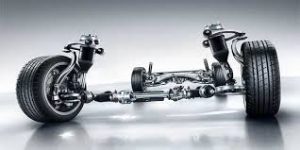How do you know when you have a problem with your cars suspension? Don’t know what the symptoms of a bad or failing suspension are?
Page Contents
First you need to know a little about how a cars suspension is designed. A vehicles suspension’s purpose and design is to help keep the tyres on the ground on bumpy roads so that you, as the driver, can maintain control of the vehicle. Good handling, steering stability and passenger comfort are all provided by having your suspension in working order.
If a road were perfectly flat, with no irregularities, suspensions wouldn’t be necessary. But roads are far from flat. Even freshly paved highways have subtle imperfections that can interact with the wheels of a car. It’s these imperfections that apply forces to the wheels.
Most automobile engineers consider the dynamics of a moving car from two perspectives:
Ride – a car’s ability to smooth out a bumpy road
Handling – a car’s ability to safely accelerate, brake and corner
Car Suspension Parts
The suspension of a car is actually part of the chassis, which comprises all of the important systems located beneath the car’s body. These systems include:
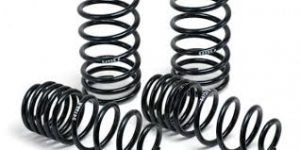
Springs:
There are a number of different types of springs but the most common we see on cars and light vans is the coil spring. It is a heavy-duty torsion bar coiled around an axis. Coil springs compress and expand to absorb the motion of the wheels. However a spring on its own is not sufficient to ensure a correct andling and comfort. As when a spring would continue to bounce on its own if it were not for another important feature:
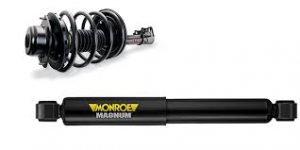
Shock Absorber:
A Shock Absorber is a device that controls unwanted spring motion through a process known as dampening. A shock absorber is basically an oil pump placed between the frame of the car and the wheels.
When the car wheel encounters a bump in the road and causes the spring to coil and uncoil, the energy of the spring is transferred to the shock absorber. The hydraulic fluid within the shock absorber slows down the movement of the shock absorber which in turn slows down the movement of the coil spring.
All modern shock absorbers are velocity-sensitive — the faster the suspension moves, the more resistance the shock absorber provides. This enables shocks to adjust to road conditions and to control all of the unwanted motions that can occur in a moving vehicle, including bounce, sway, brake dive and acceleration squat.
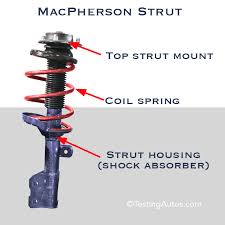
Struts:
Coil Spring and Shock absorbers can be fitted separately from one another usually on the rear of a vehicle. When they are fitted together in a Macpherson design they are usually referred to as a strut.
The Macpherson design is basically a shock absorber mounted inside a coil spring. They provide a dampening function like shock absorbers, and they provide structural support for the vehicle suspension. That means struts deliver a bit more than shock absorbers, which don’t support vehicle weight — they only control the speed at which weight is transferred in a car, not the weight itself.
Struts are always usually found fitted to the front of a vehicles suspension and are connected to the main body of the car, at the top, and at the bottom fastened to a suspension arm.
Because shocks and struts have so much to do with the handling of a car, they can be considered critical safety features. Worn shocks and struts can allow excessive vehicle-weight transfer from side to side and front to back. This reduces the tyres ability to grip the road, as well as handling and braking performance.
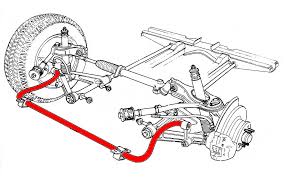
Anti-Roll Bars
Anti-Roll bars are used along with shock absorbers or struts to give a moving vehicle additional stability. An anti-roll bar is a metal rod that spans the entire axle and effectively joins each side of the suspension together.
When the suspension at one wheel moves up and down, the anti-roll bar transfers movement to the other wheel. This creates a more level ride and reduces vehicle sway. In particular, it combats the roll of a car on its suspension as it corners. For this reason, almost all cars today are fitted with anti-roll bars.
Because shocks and struts have so much to do with the handling of a car, they can be considered critical safety features. Worn shocks and struts can allow excessive vehicle-weight transfer from side to side and front to back. This reduces the tyres ability to grip the road, as well as handling and braking performance.
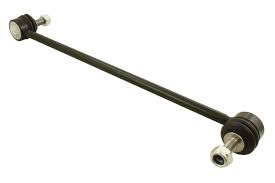
Anti-Roll Bar Link Rods
The purpose of link rods
Link rods (or stabiliser links or anti-roll bar links or drop links) connect the left and right hand suspension components to either end of the anti-roll bar. The anti-roll bar only comes into play if the suspension on one side of the car moves but the other side does not.
For example, a car drives over a speed hump that goes the full width of the road. The suspension is compressed equally each side, the anti-roll bar simply pivots – it is not twisted and there is no strain on the link rods.
But if one wheel hits a speed hump and the other does not, one end of the anti-roll bar is raised – twisting the bar. The force needed to twist the bar is all transmitted through the link rods which are normally quite light metal or plastic rods with a ball joint on either or both ends.
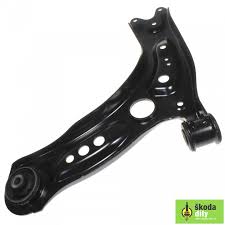
Bottom Suspension Arm
Most cars have two control arms in the front suspension. Often they are called lower control or lower suspension arms. Some cars (e.g. Honda) have four control arms, two upper and two lower arms.
A Bottom Suspension Arm connects to the frame or body of a car to the assembly that holds the front wheel. This assembly is called a steering knuckle or hub and is connected by a ball joint. The Bottom suspension arm also connects to the strut as shown in the diagram above.
Control arms are connected to the frame or body of a car through flexible rubber bushings, called control arm bushings. This allows a control arm to swing up and down as front wheels roll over bumps and potholes. The outer end of a control arm has a ball joint. In some cars, a ball joint is bolted to or pressed into the control arm and can be replaced separately. In others, a ball joint comes with a control arm as one piece. Control arms have a very important role holding both front wheels on the road. If a control arm is excessively worn, damaged or bent, the vehicle is NOT SAFE to drive.
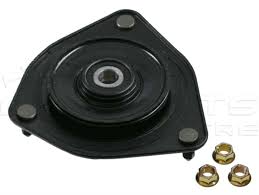
Top Strut Mount
As the name (strut mount) implies, it’s a component that attaches the suspension strut to the vehicle. In addition, it insulates the tyre noise & vibrations from the vehicle. Many front strut mounts also contain a bearing or bearing plate that serves as the steering pivot.
A strut mount is like a sandwich. One side bolts to the vehicle, the other side to the strut. In the middle is a rubber-like insulating material. So as the vehicle moves and goes over bumps, the up & down impact pushes and pulls at the mount. The mount’s job is to cushion the impacts to reduce the jarring effect, noise and vibration that could transmit into the vehicle.
On many front struts, the mount also includes a bearing that the strut attaches to. With one on each side of the vehicle, these bearings act as the steering pivots. The bearing is a critical component that affects steering movement smoothness and response.
These mounts are often overlooked but should always be replaced when changing the coil spring or strut.
Car Suspension Repairs from the Auto Care Group
The Auto Care Group offer free suspension checks at our sites in Darlington & Stockton. Contact us to ensure your cars suspension is working as it should keeping you and your passengers safe. We also offer MOT Testing, Brake Repairs and Replacement, Tyre Fitting of all makes and brand at the guaranteed lowest prices, Car and light van Servicing on all makes and models including on vehicles still under manufacturers warranty, Clutches, Wheel Alignment, Air Conditioning and all other mechanical repairs.
Darlington:
Darlington Tyre & Auto Care 01325 488855

Stockton:
Teesdale Tyre & Auto Care 01642 676667






